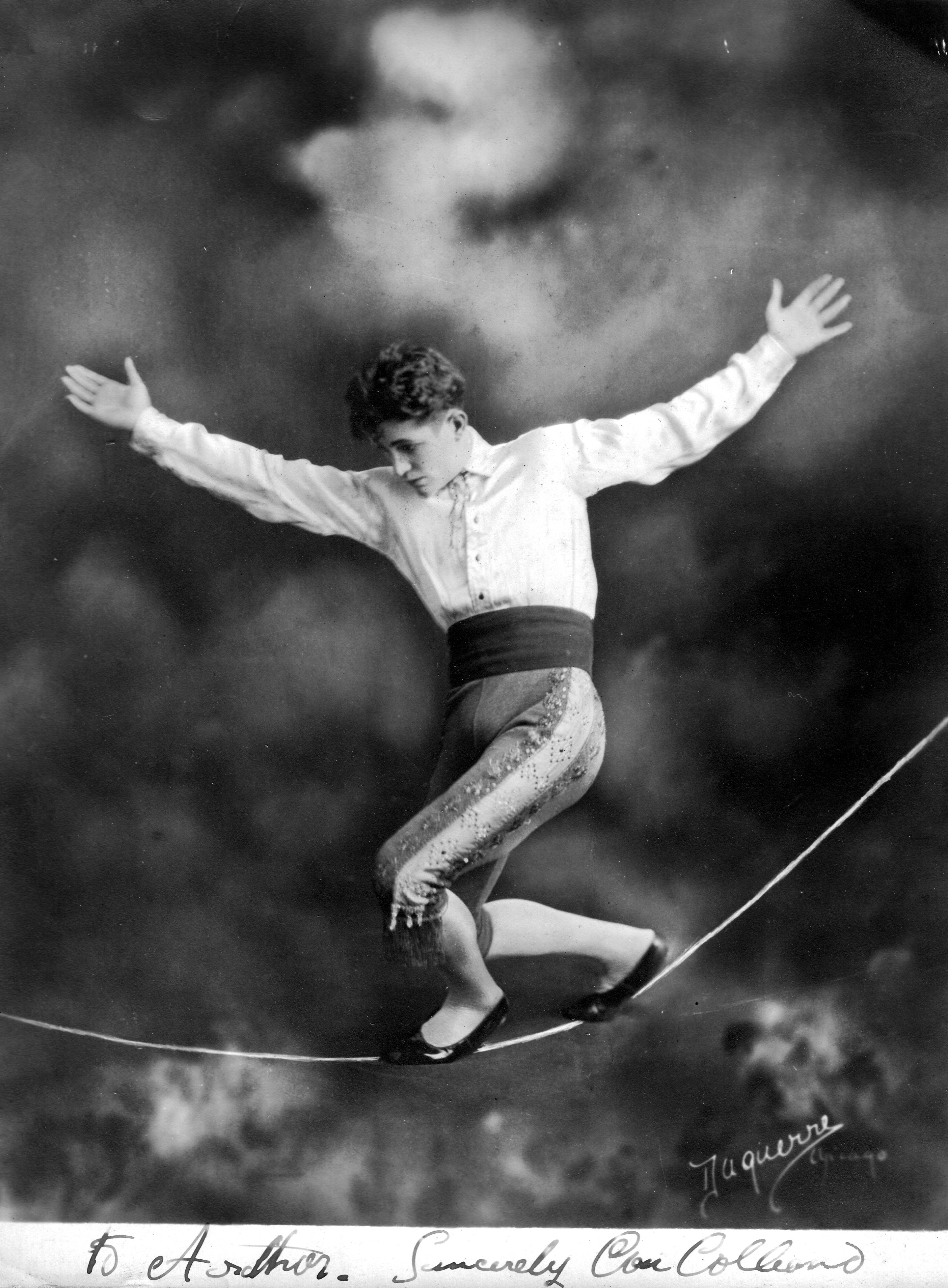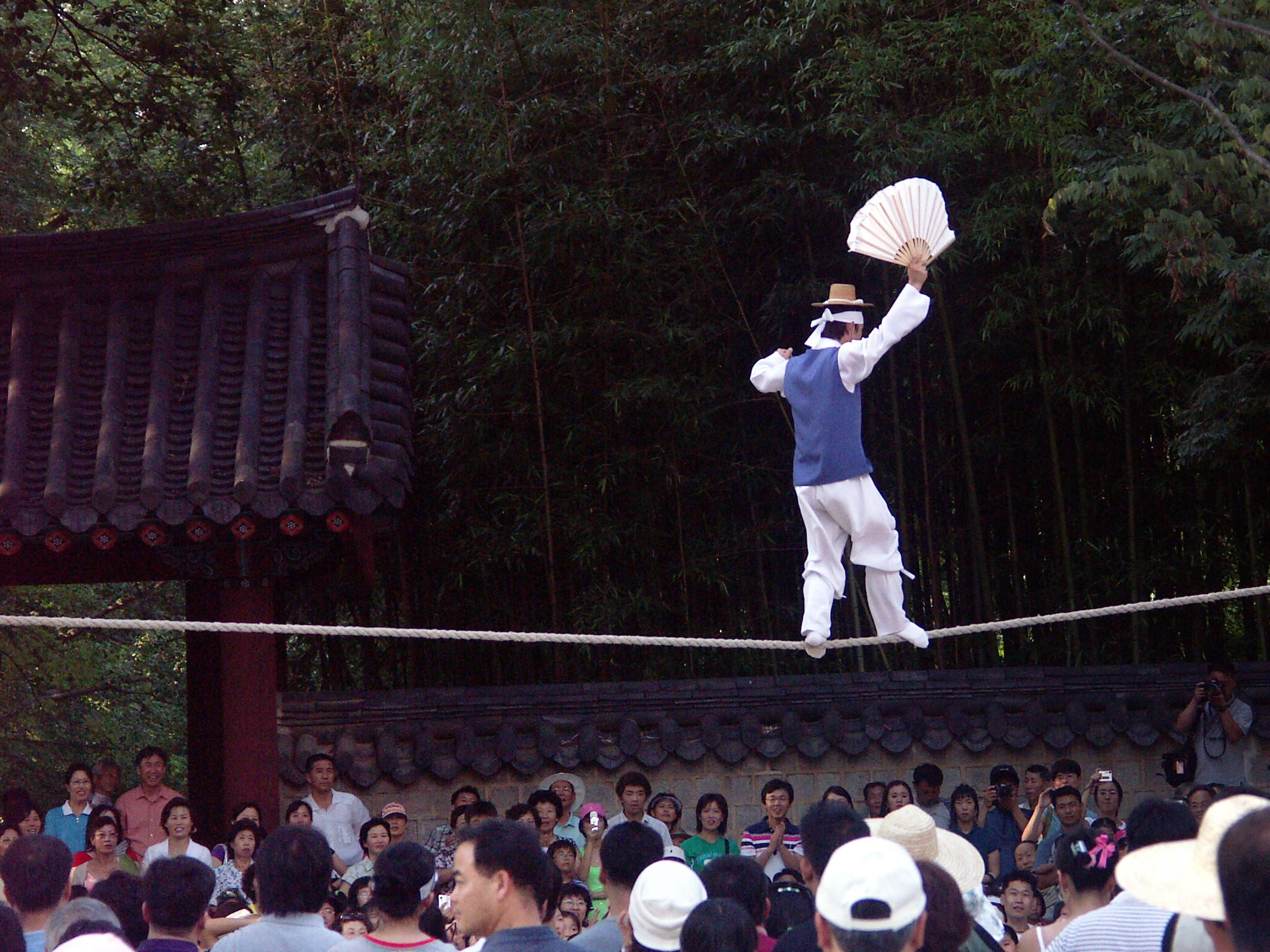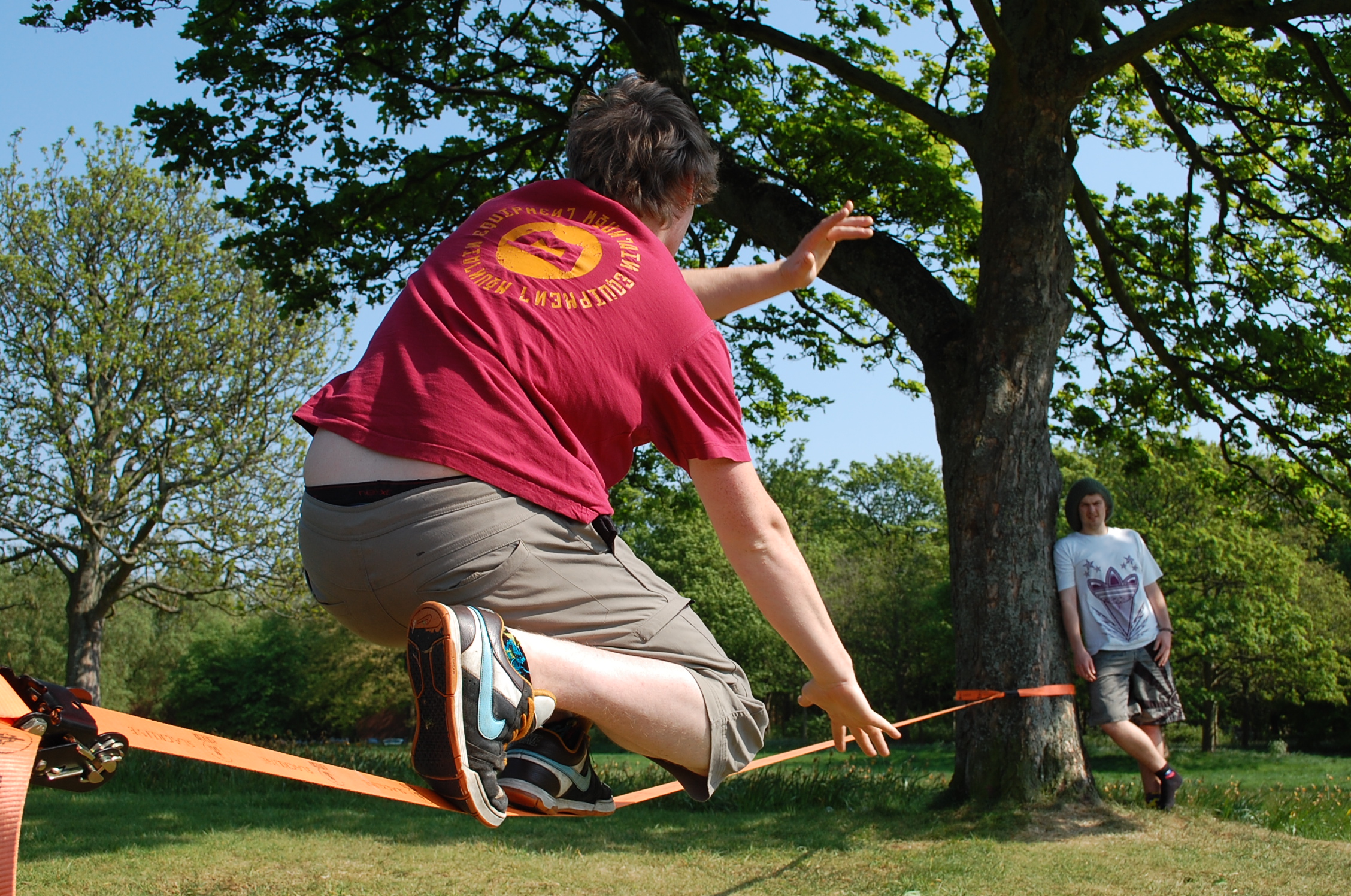Slackwire on:
[Wikipedia]
[Google]
[Amazon]
 Slackwire (or slack wire) is an
Slackwire (or slack wire) is an
 Slackwire and tightwire/tightrope require different balancing techniques: tightrope performers keep their balance by shifting their weight over the rigid tight wire, while slackwire performers use a precise swinging motion to move the relaxed slackwire under their center of mass. Because of this, an artist who works on a tightrope cannot easily make a transition to the slackwire, and vice versa. He/she needs to spend time to train himself/herself to balance in this different manner.
Some tightwire artists demonstrate a stunt called “the swings”, where the artist takes the position on the wire, then his assistant reduces the tension of the wire and the artist demonstrates swings. This stunt involves multiple skills to maintain balance. After the demonstration the assistant adjusts the wire back to its original tightness.
Slackwire and tightwire/tightrope require different balancing techniques: tightrope performers keep their balance by shifting their weight over the rigid tight wire, while slackwire performers use a precise swinging motion to move the relaxed slackwire under their center of mass. Because of this, an artist who works on a tightrope cannot easily make a transition to the slackwire, and vice versa. He/she needs to spend time to train himself/herself to balance in this different manner.
Some tightwire artists demonstrate a stunt called “the swings”, where the artist takes the position on the wire, then his assistant reduces the tension of the wire and the artist demonstrates swings. This stunt involves multiple skills to maintain balance. After the demonstration the assistant adjusts the wire back to its original tightness.Video - Volzhansky family "Prometheus"/"Прометей", 1977" (timer: 4:55)
/ref> The same stunt can also be demonstrated on a slackline.
 Slackwire and slackline are not the same; they are different kinds of apparatuses that require different techniques of balancing.
* Slackwire utilizes a steel wire in diameter, while slackline utilizes a nylon webbing/strap approximately in width.
* A slackwire has a loop and can be used like a swing; a slackline has no loop. The line is stretched tight between two anchor points like a tightrope and can only swing within a very small amplitude.
* A slackline can be used like a trampoline, allowing for an easy landing on the line after a jump. In contrast, a slackwire cannot be used like a trampoline, because when a performer jumps up from the loop of wire it will swing away with no way to anticipate its location upon landing.
Slackwire and slackline are not the same; they are different kinds of apparatuses that require different techniques of balancing.
* Slackwire utilizes a steel wire in diameter, while slackline utilizes a nylon webbing/strap approximately in width.
* A slackwire has a loop and can be used like a swing; a slackline has no loop. The line is stretched tight between two anchor points like a tightrope and can only swing within a very small amplitude.
* A slackline can be used like a trampoline, allowing for an easy landing on the line after a jump. In contrast, a slackwire cannot be used like a trampoline, because when a performer jumps up from the loop of wire it will swing away with no way to anticipate its location upon landing.
at juggling.org {{Circus skills Circus_skills Performing_arts
 Slackwire (or slack wire) is an
Slackwire (or slack wire) is an acrobatic
Acrobatics () is the performance of human feats of balance, agility, and motor coordination. Acrobatic skills are used in performing arts, sporting events, and martial arts. Extensive use of acrobatic skills are most often performed in acro ...
circus
A circus is a company of performers who put on diverse entertainment shows that may include clowns, acrobats, trained animals, trapeze acts, musicians, dancers, hoopers, tightrope walkers, jugglers, magicians, ventriloquists, and unicyclis ...
act that involves the balancing skills of moving along a flexible, thin wire suspended in the air, connected to two anchor points.
Slackwire is not to be confused with slacklining
Slacklining refers to the act of walking, running or balancing along a suspended length of flat webbing that is tensioned between two anchors. Slacklining is similar to slack rope walking and tightrope walking. Slacklines differ from tightwir ...
.
Description and setup
Usually slackwire utilizes a steel wire in diameter fixed between two anchor points. It can have two single stands with two extending wire pieces each to install the apparatus in an arena, or two A-frame stands with one extending wire piece for each. It can also be mounted between two trees at an appropriate distance apart, or fixed to a ceiling or any points which are strong enough to hold a performer's weight. Wire walking artists usually use soft shoes made of leather.Slack rope
A slack rope (or slackrope) is very similar to a slackwire. The difference between a slack rope and a slackwire is in the characteristics of rope and wire. A slack rope usually utilizes a rope in diameter. The slackwire and slack rope each have advantages and disadvantages for doing stunts. For example, it is easier and more comfortable to do "sliding" tricks on a wire than on a rope. On a slack rope a performer can walk without shoes, a feat that is painful on a slackwire. In addition, a slack rope can be used similarly to acloud swing
The cloud swing is an aerial act that usually combines static and swinging trapeze skills, drops, holds and rebound lifts.
The apparatus itself is a soft rope about 25-30mm thick. It can be made from a single rope, or from a cotton-filled sheat ...
.
Technique of balance and angle of slackwire
The performer balances or moves on the wire while needing to control the wire beneath him from moving abruptly side to side, making continual adjustments. This skill is similar to balancing a stick on one’s head or on a finger. Each slackwire performer usually uses his/her own preferred angle of slack and length of the wire. The slack angle is the V-shaped angle created when a performer stands in the middle of the walking part of the wire. The angle depends on how long or short the wire is relative to the distance between two anchor points. This also affects the amplitude of the wire's swing side to side. Some slackwire artists change the angle of the wire during their act. The degree of ease or difficulty for a performer to move the wire is dependent upon how thick the wire or rope is. The heavier the wire or rope, the more inertia is required to move it laterally, and the more force is needed to control its movement or to bring it back to a place of rest.Skills
A wide range of skills and stunts can be performed on the slack wire or slackrope. Beyond standing and walking, artists can also do turns, lying down, knee stands, sliding, forward and backward rolls, splits, handstands, cartwheels, and headstands. Props such as a ladder, chair,unicycle
A unicycle is a vehicle that touches the ground with only one wheel. The most common variation has a frame with a saddle, and has a pedal-driven direct-drive. A two speed hub is commercially available for faster unicycling. Unicycling is pract ...
, bicycle, and even a rola bola
A balance board is a device used as a circus skill, for recreation, balance training, athletic training, brain development, therapy, musical training and other kinds of personal development.
It is a lever similar to a see-saw that the user ...
have been incorporated into some acts.
Some more advanced slackwire stunts are done while the wire is swinging, including standing, handstands, and walking. Slackwire balancing skills also can be combined with tricks as various kinds of juggling
Juggling is a physical skill, performed by a juggler, involving the manipulation of objects for recreation, entertainment, art or sport. The most recognizable form of juggling is toss juggling. Juggling can be the manipulation of one object ...
, balancing a stick on the performer’s head, playing a musical instrument, etc.
Some of the same skills can be seen in cloud swing
The cloud swing is an aerial act that usually combines static and swinging trapeze skills, drops, holds and rebound lifts.
The apparatus itself is a soft rope about 25-30mm thick. It can be made from a single rope, or from a cotton-filled sheat ...
or trapeze
A trapeze is a short horizontal bar hung by ropes or metal straps from a ceiling support. It is an aerial apparatus commonly found in circus performances. Trapeze acts may be static, spinning (rigged from a single point), swinging or flying, an ...
acts as well.
Jumping rope on a slack wire
Jumping rope
A skipping rope (British English) or jump rope (American English) is a tool used in the sport of skipping/jump rope where one or more participants jump over a rope swung so that it passes under their feet and over their heads. There are mult ...
has been performed on the tightrope
Tightrope walking, also called funambulism, is the skill of walking along a thin wire or rope. It has a long tradition in various countries and is commonly associated with the circus. Other skills similar to tightrope walking include slack rope ...
and slackline
Slacklining refers to the act of walking, running or balance (ability), balancing along a suspended length of flat webbing that is tension (physics), tensioned between two anchor (climbing), anchors. Slacklining is similar to Slackwire#Slack rope ...
, but is difficult on a slackwire because the wire moves when the performer jumps up, and there is no way to control the swing and position of the wire when landing. This makes such stunts as somersaults and acrobatic tumbling virtually impossible. Jumping rope on a slackwire was first accomplished in 1985. The only person to accomplish the stunt is Sergey Pavlov (the clown LALALA). Sergey has been able to complete up to seven consecutive jumps.
Similarities and differences
Slackwire vs. tightrope
Slackwire andtightrope
Tightrope walking, also called funambulism, is the skill of walking along a thin wire or rope. It has a long tradition in various countries and is commonly associated with the circus. Other skills similar to tightrope walking include slack rope ...
appear to be very similar skills to walking and balancing on a thin wire or rope. In fact, the technique of balance is very different between them.
 Slackwire and tightwire/tightrope require different balancing techniques: tightrope performers keep their balance by shifting their weight over the rigid tight wire, while slackwire performers use a precise swinging motion to move the relaxed slackwire under their center of mass. Because of this, an artist who works on a tightrope cannot easily make a transition to the slackwire, and vice versa. He/she needs to spend time to train himself/herself to balance in this different manner.
Some tightwire artists demonstrate a stunt called “the swings”, where the artist takes the position on the wire, then his assistant reduces the tension of the wire and the artist demonstrates swings. This stunt involves multiple skills to maintain balance. After the demonstration the assistant adjusts the wire back to its original tightness.
Slackwire and tightwire/tightrope require different balancing techniques: tightrope performers keep their balance by shifting their weight over the rigid tight wire, while slackwire performers use a precise swinging motion to move the relaxed slackwire under their center of mass. Because of this, an artist who works on a tightrope cannot easily make a transition to the slackwire, and vice versa. He/she needs to spend time to train himself/herself to balance in this different manner.
Some tightwire artists demonstrate a stunt called “the swings”, where the artist takes the position on the wire, then his assistant reduces the tension of the wire and the artist demonstrates swings. This stunt involves multiple skills to maintain balance. After the demonstration the assistant adjusts the wire back to its original tightness./ref> The same stunt can also be demonstrated on a slackline.
Slackwire vs. slackline
 Slackwire and slackline are not the same; they are different kinds of apparatuses that require different techniques of balancing.
* Slackwire utilizes a steel wire in diameter, while slackline utilizes a nylon webbing/strap approximately in width.
* A slackwire has a loop and can be used like a swing; a slackline has no loop. The line is stretched tight between two anchor points like a tightrope and can only swing within a very small amplitude.
* A slackline can be used like a trampoline, allowing for an easy landing on the line after a jump. In contrast, a slackwire cannot be used like a trampoline, because when a performer jumps up from the loop of wire it will swing away with no way to anticipate its location upon landing.
Slackwire and slackline are not the same; they are different kinds of apparatuses that require different techniques of balancing.
* Slackwire utilizes a steel wire in diameter, while slackline utilizes a nylon webbing/strap approximately in width.
* A slackwire has a loop and can be used like a swing; a slackline has no loop. The line is stretched tight between two anchor points like a tightrope and can only swing within a very small amplitude.
* A slackline can be used like a trampoline, allowing for an easy landing on the line after a jump. In contrast, a slackwire cannot be used like a trampoline, because when a performer jumps up from the loop of wire it will swing away with no way to anticipate its location upon landing.
References
External links
at juggling.org {{Circus skills Circus_skills Performing_arts